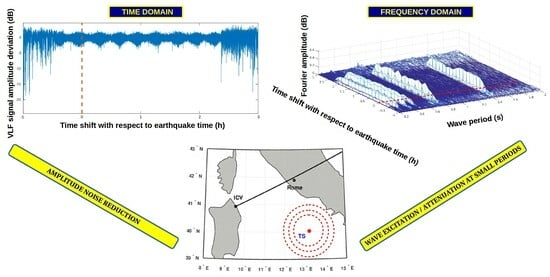Analysis of VLF Signal Noise Changes in the Time Domain and Excitations/Attenuations of Short-Period Waves in the Frequency Domain as Potential Earthquake Precursors
Abstract
1. Introduction
2. Observations and Data Processing
2.1. Observational Setup and Studied Earthquake Events
- Mw 5.4 that occurred near Kraljevo (K1; 43.74°N, 20.69°E) on 3 November 2010;
- mb 5.1 that occurred in the Tyrrhenian Sea (TS; 40.03°N, 13.2°E) on 3 November 2010;
- ML 4.4 that occurred near Kraljevo (K2; 43.78°N, 20.62°E) on 4 November 2010 (since this location is very close to the location of the K1 earthquake epicentre, the same star refers to both these earthquakes);
- ML 4.3 that occurred in the Western Mediterranean Sea (WMS; 42.25°N, 6.77°E) on 9 November 2010.
2.2. Data of the ICV Signal Amplitude Analyzed in Detail in This Study
2.3. Data Processing
2.3.1. Data Analyses in the Time Domain
2.3.2. Data Analyses in the Frequency Domain
- The error in the time determinations is the step between two WTIs, e.g., 10 min.
- The error in the determination of T is not the same because these values are not equidistant (in FFT the values of frequency f are equidistant), and depends on its values. It can be determined in two ways:
- -
- In the case of high frequencies, e.g., low wave periods (here, we consider the maximum value for this case of 1 min) for which the differences of adjacent values are small, an approximate determination of the error is made from the relationship between the wave period and frequency (), and the error of frequency : where (for WTI of 20 min, 1 h and 3 h, the values of are 8.3333 × 10 Hz, 2.7778 × 10 Hz, and 9.2593 × 10 Hz, respectively).
- -
- In the case of lower frequencies, i.e., the wave periods longer than 1 min, the error is determined by the absolute difference of a certain value of T and the first more discrete value of this parameter.
- For the same reason as in the case of determining the reduction of the amplitude and phase noise, the increasing and decreasing of is determined visually.
2.4. Comparisons of the Parameters Relevant for the Statistical Analyses Related to the Considered Possible Earthquake Precursors
- The reductions in the VLF signal amplitude and phase noises in the time domain;
- The excitations of waves at discrete low values of wave periods (below 1.5 s) and the attenuations of waves at other wavelengths that may have upper limit values after which changes are not observed. These effects are visible in the frequency domain.
3. Results and Discussion
3.1. Analysis of the Signal Amplitude in the Frequency Domain
3.1.1. Analysis of the ICV Signal Amplitude in a Quiet Period
- Increases and decreases in in time are not recorded in the upper panels showing the results for WTI = 20 min. In other words, excitations and attenuations of waves with a wave period below 10 min are not visible.
- has higher values during the periods of sunset and sunrise, which is a consequence of intense variations in the signal amplitude time evolution, which include pronounced minima (see, for example, [31,32]). Here, we emphasize that the variations in last for a long time because specific data provide integral information for the relevant time interval WTI to which the FFT is applied.
3.1.2. Analysis of the ICV Signal Amplitude in the Period around the TS Earthquake
- As in the studies presented in [11,22], the wave excitations are visible at small discrete values of the wave periods below 1.5 s. They can be seen in the upper left panel for WTI = 20 min (for smaller values of T) in the time interval starting (40 ± 10) min before the TS earthquake and ending (130 ± 10) min after it. The specific values of the periods of the excited waves are (0.2333 ± 0.0001) s, (0.2800 ± 0.0001) s, (0.3500 ± 0.0002) s, (0.4667 ± 0.0002) s, (0.7001 ± 0.0005) s, and (1.400 ± 0.002) s. The stated errors are determined based on the explanation given in Section 2. A clearer representation of the jumps representing the indicated wave excitations is shown in Figure 7 where the dependencies (in moments when wave excitations are visible) are given for all four considered cases.
- The wave attenuations, manifested as decreases in , are recorded for all values of T from its minimum value to 15 min except for those at which the indicated wave excitations are visible. They occur in similar time intervals as the mentioned excitations (determined on the panels for WTI = 20 for the best accuracy). The value of 15 min is determined in the graph for WTI = 1 h (lower left panel in Figure 4) because of better precision than in the case for WTI = 3 h (lower right panel). Here, we emphasize that this determination is not relevant for WTI = 20 min since the maximum value of T in that case is 10 min (half of WTI).
3.1.3. Analysis of the ICV Signal Amplitude in the Period around the K2 Earthquake
- By the analyses of the signal characteristics in the periods of other earthquakes, the lasting of the wave excitation/attenuation period can be related to the number of earthquakes that occur within a relatively short time period.
- The magnitudes of the additional earthquakes are below 3.5 because that indicates that the dependence of the earthquake intensity and the excited/attenuated waves characteristics are not simple and that their examinations require the analyses of statistically significant samples with the inclusion of additional parameters that characterize the considered earthquakes, positions of their epicenters relative to the considered signal propagation path, signal, and states of the atmosphere.
- The wave excitations are visible in the time interval starting (20 ± 10) min before the K2 earthquake and ending (10 ± 10) min after it at the wave periods of (0.2333 ± 0.0001) s, (0.2000 ± 0.0001) s, (0.2800 ± 0.0001) s, (0.3500 ± 0.0002) s, (0.4667 ± 0.0002) s, (0.7001 ± 0.0005) s, and (1.400 ± 0.002) s. As in the first case, is determined from the upper left panel of the corresponding figure (WTI = 20 min), and the stated errors are determined based on the explanation given in Section 2. Also, a clearer representation of the jumps representing the indicated wave excitations is shown in Figure 7.
- As in the first case, the wave attenuations, manifested as decreases in , are visible in similar time intervals as the mentioned excitations for all values of T from its minimum value to 6.667 min except for those at which the indicated wave excitations are visible (see the both upper panels for WTI = 20 min, and the bottom left panel for WTI = 1 h).
3.1.4. Analysis of the ICV Signal Amplitude in the Period around the WMS Earthquake
- The wave excitations are visible in the time interval starting (100 ± 10) min before the WMS earthquake and ending (30 ± 10) min after it at the wave periods of (0.2333 ± 0.0001) s, (0.2800 ± 0.0001) s, (0.3500 ± 0.0002) s, (0.4667 ± 0.0002) s, (0.7001 ± 0.0005) s, and (1.400 ± 0.002) s (see Figure 7).
- As in the first case, the wave attenuations manifested as decreases in , are visible in similar time intervals as the mentioned excitations for all values of T from its minimum value to 5.455 min except for those at which the indicated wave excitations are visible (see both upper panels for WTI = 20 min, and the bottom left panel for WTI = 1 h).
3.1.5. Comparisons of the Obtained Results
- The beginnings of changes in are recorded before the time of the earthquake;
- Wave excitations are most pronounced for discrete values of period T below 1.5 s;
- The best representation of wave excitations is obtained for minimum time intervals of 20 min;
- Wave attenuations during those time intervals are pronounced for other periods below several minutes.
3.2. Defining of VLF Signal Amplitude and Phase Parameters in the Time and Frequency Domains as Potential Earthquake Precursors
- In the time domain according to:
- -
- Characteristics of the amplitude/phase noise reduction,
- In the frequency domain according to:
- -
- Characteristics of excited waves before an earthquake at discrete values of the wave periods lower than 1.5 s,
- -
- Characteristics of attenuated waves on other wave periods with or without visible limitations in the upper limit of the observed domain.
- In the time domain:
- -
- The start time of the amplitude/phase noise reduction in relation to the time of the considered earthquake,
- -
- The end time of the amplitude/phase noise reduction in relation to the time of the considered earthquake;
- In the frequent domain:
- -
- The start time of the wave excitation/attenuation in relation to the time of the considered earthquake,
- -
- The end time of the wave excitation/attenuation in relation to the time of the considered earthquake,
- -
- Discrete values of of the excited waves,
- -
- The upper limit of the wave period domain within the wave attenuation is visible;
3.2.1. Intervals of Changes in the Time and Frequency Domains
- The times and are the same (in three cases) and similar (in the last case) in the time evolutions of the amplitude and phase of the ICV signal, while the time intervals in which the increases in the Fourier amplitude are observed are the same for both signal parameters. Discrepancies in and for the amplitude and phase of 20 min and 2 min, respectively, are recorded in the case of an earthquake that differs from the others in the position of its epicenter in relation to the signal path (the distance is the greatest and it is located to the west of the transmitter), and in the type of the noise amplitude reduction which, according to the study given in [33], indicates the displacement of the amplitude values after the reduction of its noise (it is a reduction in Type II in contrast to other cases where they are reductions in Type I). For this reason, the characteristics that should be the subject of analysis in statistical studies are the relationships between the times and for the signal amplitude and phase, as well as the connection of the discrepancy of these times with the reduction type.
- The times and are the same for the amplitude and phase for all cases.
- The times and , and and are not the same for different events. Although they depend on the occurrence of other earthquakes, the investigation of these parameters depending on the magnitude and depth of the earthquake, and the position of its epicentre in relation to the observed VLF signal propagation path is of essential importance for the analyses of the considered changes as possible precursors of earthquakes. Of course, a sample of a significantly larger number of events that can be observed independently is necessary for that and, as stated earlier, this issue will be the subject of future research.
- The start and end times of disturbances are not the same in the time and frequency domains. Here, it should be kept in mind that the resolution in the second case is worse due to the shift in the time intervals on which the Fourier transform is applied in steps of 10 min, and due to the fact that the results of transformation refer to the entire observed time intervals . Although the comparison of the mentioned times is not relevant due to the given reasons, it is noticeable that the obtained differences are different in different cases. This variation indicates the need for more detailed statistical analysis to determine the existence or non-existence of their dependence on the characteristics of earthquakes and signals.
3.2.2. Characteristics of the Wave Excitations and Attenuation Periods
- The periods of the excited waves recorded in the analysis of both the signal amplitude and phase for all four earthquakes are (0.2333 ± 0.0001) s, (0.2800 ± 0.0001) s, (0.3500 ± 0.0002) s, (0.4667 ± 0.0002) s, and (0.7001 ± 0.0005) s. Waves with the period of (1.400 ± 0.002) s are excited in all cases except in the case of the amplitude during the period around the K1 earthquake. (Here, we observe all excitations in contrast to the study given in [22] where only the most significant ones are listed.)
- Wave excitations with (0.2000 ± 0.0001) s are recorded only in the phase analysis for the K1 earthquake, and in the amplitude analysis for the K2 earthquake.
4. Conclusions
- 1.
- Completing the analysis of the 20.27 kHz ICV signal amplitude in the frequency domain for the time periods around the remaining three earthquakes (in the Tyrrhenian Sea on 3 November 2010, near Kraljevo on 4 November 2010, and in the Western Mediterranean Sea on 9 November 2010) that occurred near the path of the observed radio signal emitted by the ICV transmitter in Italy and recorded in Serbia.
- 2.
- Determination of VLF signal amplitude and phase parameters in the time and frequency domains that can be considered as potential earthquake precursors from comparisons of specific changes in the ICV signal amplitude and phase during the time period around the analyzed four earthquakes.
- Excitation of waves with the wave periods below 1.5 s before the earthquake;
- Attenuation of waves for other periods below several minutes;
- The choice of the time interval on which the Fourier transformation is performed affects the clarity of the observed excitations and attenuations displayed. The best visibility is obtained for the shortest observed window time intervals of 20 min.
- The start and end times of the noise reduction in the time evolutions of the ICV signal amplitude and phase are the same in the three cases where the amplitude reduction is the reduction in Type I (the amplitude noise reduction is a consequence of increasing the minimum and decreasing the maximum values of the signal amplitude), and different in the case of the earthquake for which the noise reduction is the reduction in Type II (the amplitude noise reduction is a consequence of increasing the minimum values of the signal amplitude) and whose epicenter is farthest from the signal path and located west from the ICV transmitter;
- The time intervals in which the observed Fourier amplitude excitation is the same for both signal parameters;
- The start and end times of disturbances in relation to the time of the earthquake are various for different events;
- The start and end times of disturbances are not the same in the time and frequency domains and these differences are not the same for different events;
- The periods of the excited waves match for all considered earthquakes and both signal parameters for (0.2333 ± 0.0001) s, (0.2800 ± 0.0001) s, (0.3500 ± 0.0002) s, (0.4667 ± 0.0002) s, and (0.7001 ± 0.0005) s, while the wave excitations with the period of (1.400 ± 0.002) s are absent only in the case of the amplitude for the Kraljevo earthquake that occurred on 3 November 2010;
- The wave period domains of wave attenuations are much more pronounced for the Fast Fourier transform of the phase time evolution, where they are not limited in the observed ranges if the time period of the change is large enough. In the case of the Fast Fourier transform of the signal amplitude, the attenuation is present on smaller wave periods, and their upper limit of a few minutes is not clearly defined.
- The start and end times of the VLF signal amplitude and phase noise reductions in the time domain, their comparisons, and connecting the (non)existence of corresponding differences with the type of noise amplitude reduction;
- The start and end times of the excited/attenuated waves of the amplitude and phase in the frequency domain;
- Differences in the start and end times of corresponding disturbances in the time and frequency domains;
- The wave periods of the amplitude and phase wave excitations in the frequency domain.
Funding
Data Availability Statement
Acknowledgments
Conflicts of Interest
References
- Davies, K.; Baker, D.M. Ionospheric effects observed around the time of the Alaskan earthquake of March 28, 1964. J. Geophys. Res. 1965, 70, 2251–2253. [Google Scholar] [CrossRef]
- Leonard, R.S.; Barnes, R.A.J. Observations of Ionospheric Disturbances Following the Alaska Earthquake. J. Geophys. Res. 1965, 70, 1250–1253. [Google Scholar] [CrossRef]
- Yuen, P.C.; Weaver, P.F.; Suzuki, R.K.; Furumoto, A.S. Continuous, traveling coupling between seismic waves and the ionosphere evident in May 1968 Japan earthquake data. J. Geophys. Res. 1969, 74, 2256–2264. [Google Scholar] [CrossRef]
- Molchanov, O.; Hayakawa, M.; Oudoh, T.; Kawai, E. Precursory effects in the subionospheric VLF signals for the Kobe earthquake. Phys. Earth Planet. Inter. 1998, 105, 239–248. [Google Scholar] [CrossRef]
- Biagi, P.F.; Piccolo, R.; Ermini, A.; Martellucci, S.; Bellecci, C.; Hayakawa, M.; Kingsley, S.P. Disturbances in LF radio-signals as seismic precursors. Ann. Geophys. 2001, 44, 1011–1019. [Google Scholar] [CrossRef]
- Němec, F.; Santolík, O.; Parrot, M. Decrease of intensity of ELF/VLF waves observed in the upper ionosphere close to earthquakes: A statistical study. J. Geophys. Res. Space Phys. 2009, 114, A04303. [Google Scholar] [CrossRef]
- Maurya, A.K.; Venkatesham, K.; Tiwari, P.; Vijaykumar, K.; Singh, R.; Singh, A.K.; Ramesh, D.S. The 25 April 2015 Nepal Earthquake: Investigation of precursor in VLF subionospheric signal. J. Geophys. Res. Space Phys. 2016, 121, 10403–10416. [Google Scholar] [CrossRef]
- Price, C.; Yair, Y.; Asfur, M. East African lightning as a precursor of Atlantic hurricane activity. Geophys. Res. Lett. 2007, 34, 9805. [Google Scholar] [CrossRef]
- Biagi, P.F.; Maggipinto, T.; Righetti, F.; Loiacono, D.; Schiavulli, L.; Ligonzo, T.; Ermini, A.; Moldovan, I.A.; Moldovan, A.S.; Buyuksarac, A.; et al. The European VLF/LF radio network to search for earthquake precursors: Setting up and natural/man-made disturbances. Nat. Hazards Earth Syst. Sci. 2011, 11, 333–341. [Google Scholar] [CrossRef]
- Kumar, S.; NaitAmor, S.; Chanrion, O.; Neubert, T. Perturbations to the lower ionosphere by tropical cyclone Evan in the South Pacific Region. J. Geophys. Res. Space Phys. 2017, 122, 8720–8732. [Google Scholar] [CrossRef]
- Nina, A.; Pulinets, S.; Biagi, P.; Nico, G.; Mitrović, S.; Radovanović, M.; Č. Popović, L. Variation in natural short-period ionospheric noise, and acoustic and gravity waves revealed by the amplitude analysis of a VLF radio signal on the occasion of the Kraljevo earthquake (Mw = 5.4). Sci. Total Environ. 2020, 710, 136406. [Google Scholar] [CrossRef] [PubMed]
- Hayakawa, M. The precursory signature effect of the Kobe earthquake on VLF subionospheric signals. J. Comm. Res. Lab. 1996, 43, 169–180. [Google Scholar]
- Yamauchi, T.; Maekawa, S.; Horie, T.; Hayakawa, M.; Soloviev, O. Subionospheric VLF/LF monitoring of ionospheric perturbations for the 2004 Mid-Niigata earthquake and their structure and dynamics. J. Atmos. Sol.-Terr. Phys. 2007, 69, 793–802. [Google Scholar] [CrossRef]
- Biagi, P.; Castellana, L.; Maggipinto, T.; Piccolo, R.; Minafra, A.; Ermini, A.; Martellucci, S.; Bellecci, C.; Perna, G.; Capozzi, V.; et al. LF radio anomalies revealed in Italy by the wavelet analysis: Possible preseismic effects during 1997–1998. Phys. Chem. Earth Parts A/B/C 2006, 31, 403–408. [Google Scholar] [CrossRef]
- Hayakawa, M.; Horie, T.; Muto, F.; Kasahara, Y.; Ohta, K.; Liu, J.Y.; Hobara, Y. Subionospheric VLF/LF Probing of Ionospheric Perturbations Associated with Earthquakes: A Possibility of Earthquake Prediction. SICE J. Control Meas. Syst. Integr. 2010, 3, 10–14. [Google Scholar] [CrossRef]
- Molchanov, O.; Hayakawa, M.; Miyaki, K. VLF/LF sounding of the lower ionosphere to study the role of atmospheric oscillations in the lithosphere-ionosphere coupling. Adv. Polar Up. Atmos. Res. 2001, 15, 146–158. [Google Scholar]
- Ohya, H.; Tsuchiya, F.; Takishita, Y.; Shinagawa, H.; Nozaki, K.; Shiokawa, K. Periodic Oscillations in the D Region Ionosphere After the 2011 Tohoku Earthquake Using LF Standard Radio Waves. J. Geophys. Res. Space Phys. 2018, 123, 5261–5270. [Google Scholar] [CrossRef]
- Rozhnoi, A.; Solovieva, M.; Molchanov, O.; Hayakawa, M. Middle latitude LF (40 kHz) phase variations associated with earthquakes for quiet and disturbed geomagnetic conditions. Phys. Chem. Earth Parts A/B/C 2004, 29, 589–598. [Google Scholar] [CrossRef]
- Song, D.; Chen, Z.; Ke, Y.; Nie, W. Seismic response analysis of a bedding rock slope based on the time-frequency joint analysis method: A case study from the middle reach of the Jinsha River, China. Eng. Geol. 2020, 274, 105731. [Google Scholar] [CrossRef]
- Madley, M.; Yates, A.; Savage, M.; Wang, W.; Okada, T.; Matsumoto, S.; Iio, Y.; Jacobs, K. Velocity changes around the Kaikōura earthquake ruptures from ambient noise cross-correlations. Geophys. J. Int. 2022, 229, 1357–1371. [Google Scholar] [CrossRef]
- Bonilla, L.F.; Ben-Zion, Y. Detailed space–time variations of the seismic response of the shallow crust to small earthquakes from analysis of dense array data. Geophys. J. Int. 2021, 225, 298–310. [Google Scholar] [CrossRef]
- Nina, A.; Biagi, P.F.; Mitrović, S.T.; Pulinets, S.; Nico, G.; Radovanović, M.; Popović, L.Č. Reduction of the VLF Signal Phase Noise Before Earthquakes. Atmosphere 2021, 12, 444. [Google Scholar] [CrossRef]
- The Euro-Mediterranean Seismological Centre. Available online: https://www.emsc-csem.org/ (accessed on 5 February 2021).
- Hanks, T.C.; Kanamori, H. A moment magnitude scale. J. Geophys. Res. Solid Earth 1979, 84, 2348–2350. [Google Scholar] [CrossRef]
- Kanamori, H. Magnitude scale and quantification of earthquakes. Tectonophysics 1983, 93, 185–199. [Google Scholar] [CrossRef]
- Richter, C.F. An instrumental earthquake magnitude scale. Bull. Seismol. Soc. Am. 1935, 25, 1–32. [Google Scholar] [CrossRef]
- Bormann, P.; Wendt, S.; DiGiacomo, D. Seismic sources and source parameters. In New Manual of Seismological Observatory Practice 2 (NMSOP2); Deutsches GeoForschungsZentrum GFZ: Potsdam, Germany, 2013; Volume 25, pp. 1–259. [Google Scholar] [CrossRef]
- Zare, M.; Amini, H.; Yazdi, P.; Sesetyan, K.; Demircioglu, M.B.; Kalafat, D.; Erdik, M.; Giardini, D.; Khan, M.A.; Tsereteli, N. Recent developments of the Middle East catalog. J. Seismol. 2014, 18, 749–772. [Google Scholar] [CrossRef]
- Mereu, R.F. A study of the relations between ML, Me, Mw, apparent stress, and fault aspect ratio. Phys. Earth Planet. Inter. 2020, 298, 106278. [Google Scholar] [CrossRef]
- Nina, A.; Simić, S.; Srećković, V.A.; Popović, L.Č. Detection of short-term response of the low ionosphere on gamma ray bursts. Geophys. Res. Lett. 2015, 42, 8250–8261. [Google Scholar] [CrossRef]
- Nina, A.; Čadež, V.M.; Popović, L.Č.; Srećković, V.A. Diagnostics of plasma in the ionospheric D-region: Detection and study of different ionospheric disturbance types. Eur. Phys. J. D 2017, 71, 189. [Google Scholar] [CrossRef]
- Kolarski, A.; Srećković, V.; Langović, M.; Arnaut, F. Energetic solar flare events in relation with subionospheric impact on 6–10 September 2017: Data and modeling. Contrib. Astron. Obs. Skaln. Pleso 2023, 53, 138–147. [Google Scholar] [CrossRef]
- Nina, A.; Biagi, P.F.; Pulinets, S.; Nico, G.; Mitrović, S.T.; Čadež, V.M.; Radovanović, M.; Urošev, M.; Popović, L.Č. Variation in the VLF signal noise amplitude during the period of intense seismic activity in Central Italy from 25 October to 3 November 2016. Front. Environ. Sci. 2022, 10, 1005575. [Google Scholar] [CrossRef]
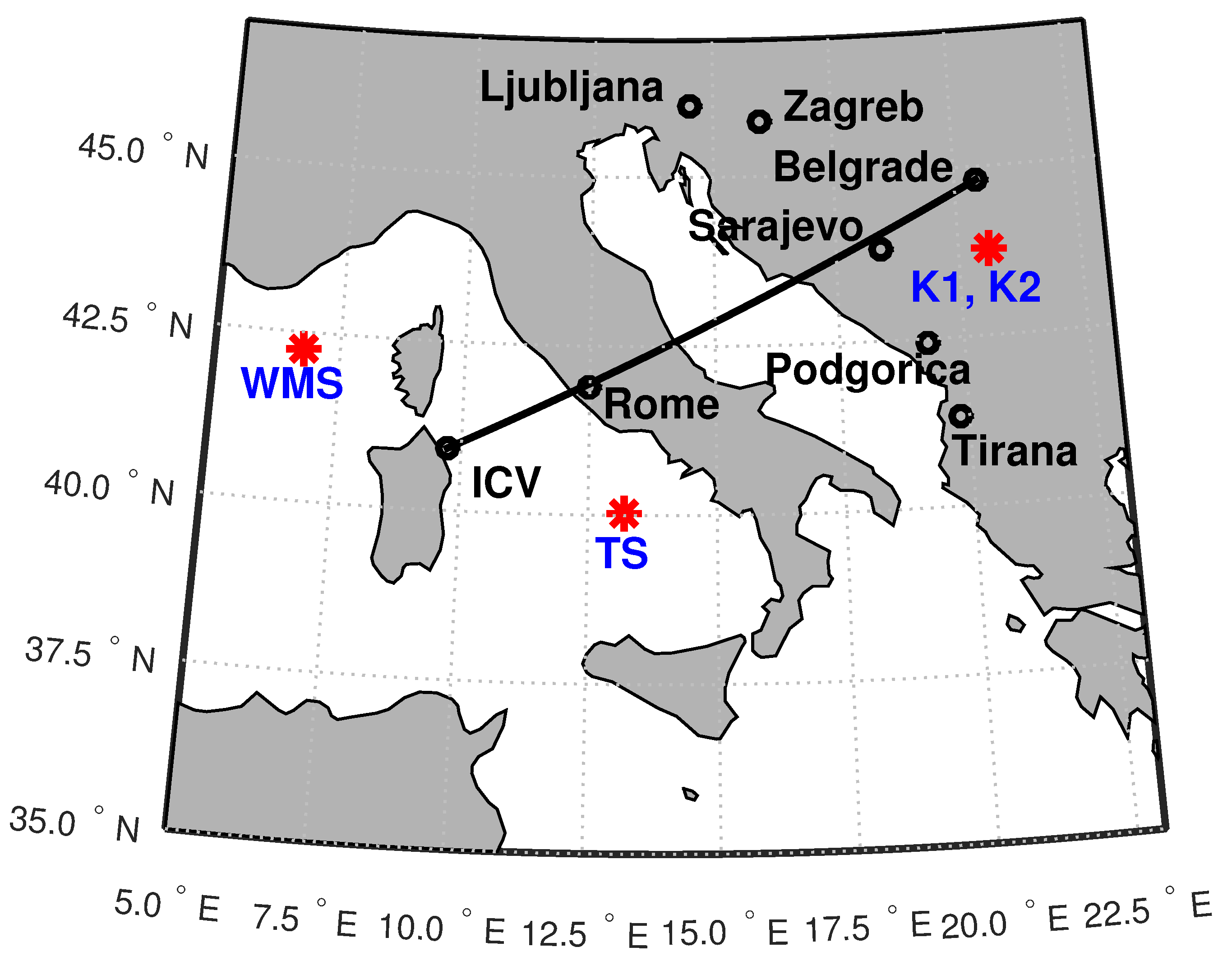


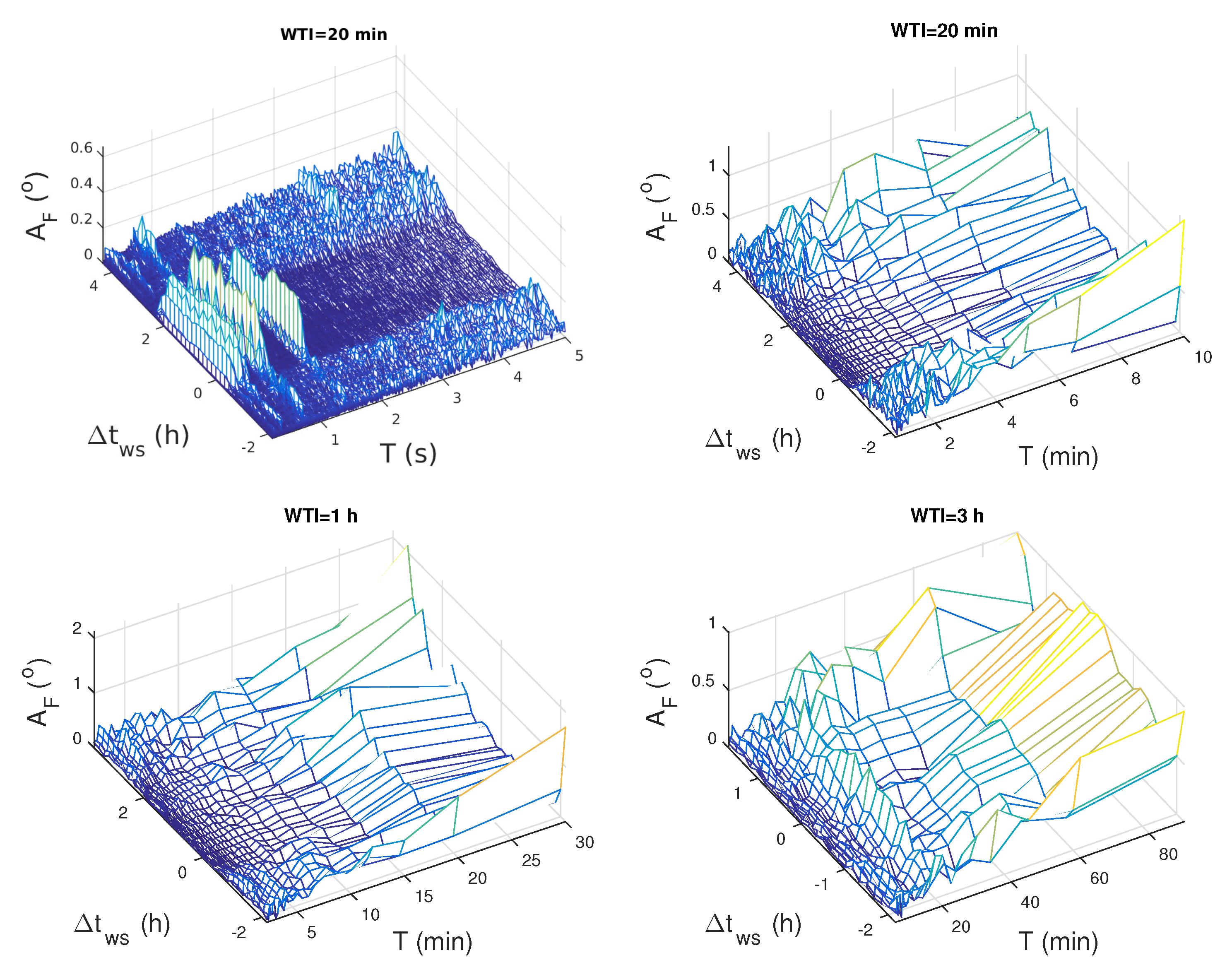
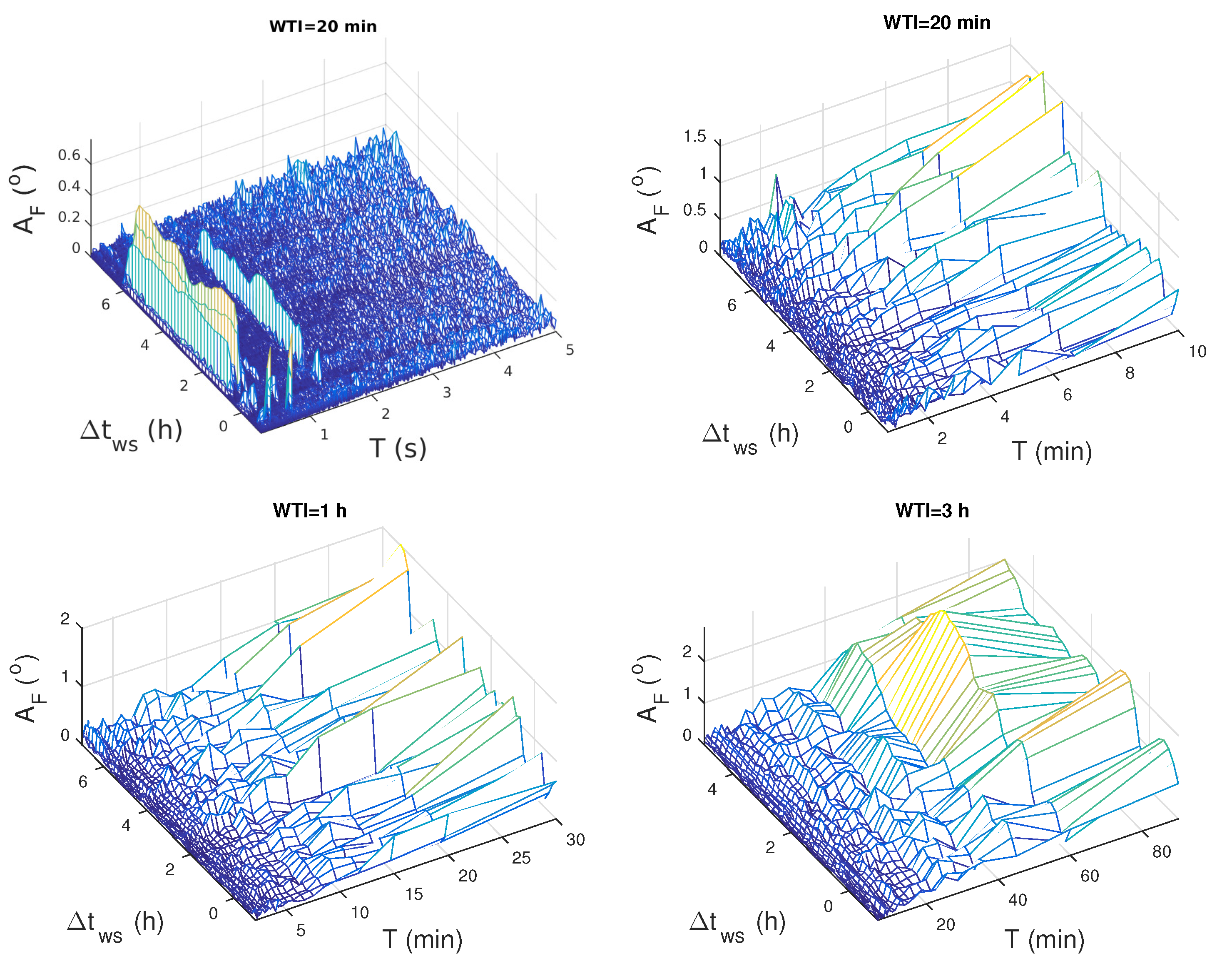
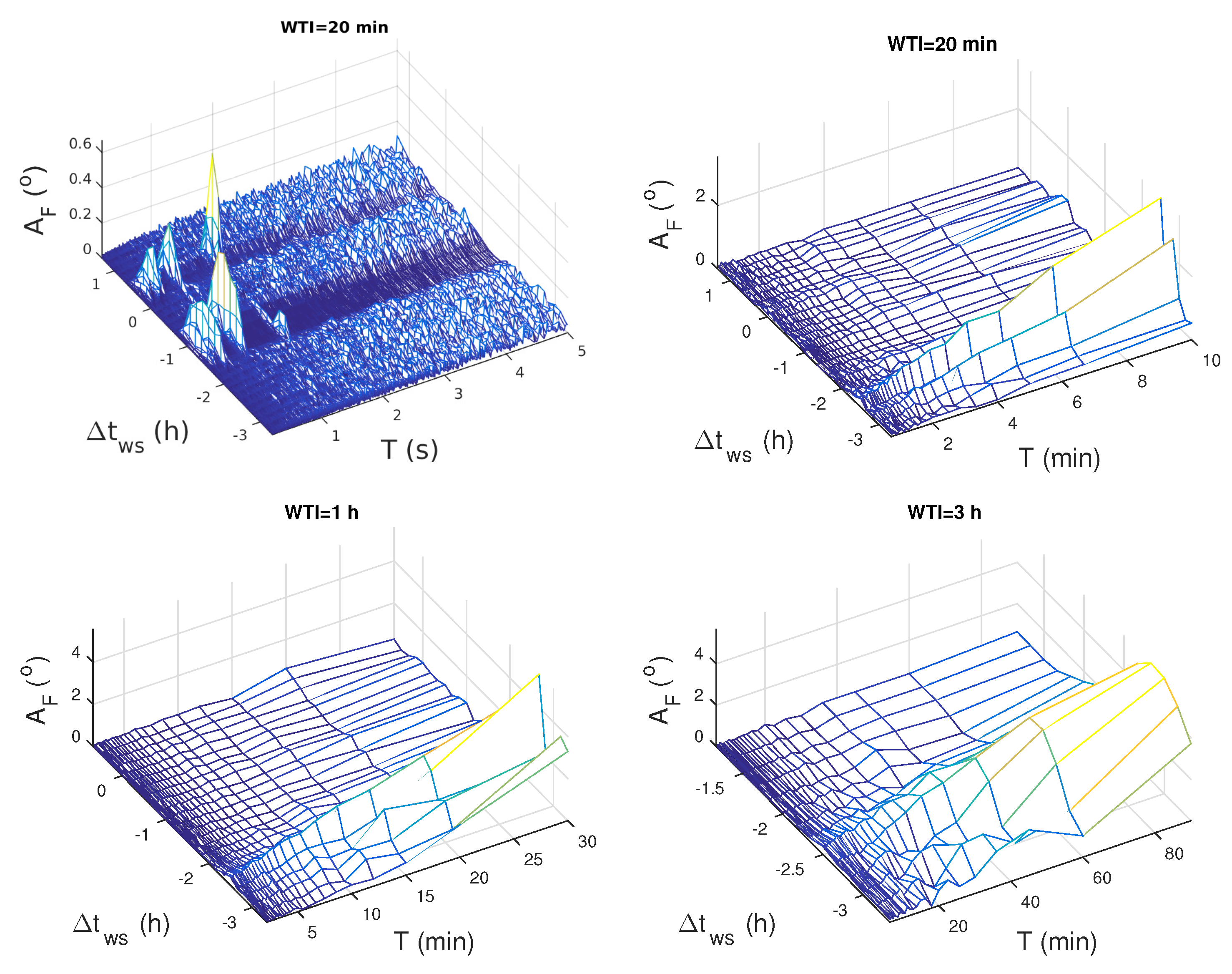
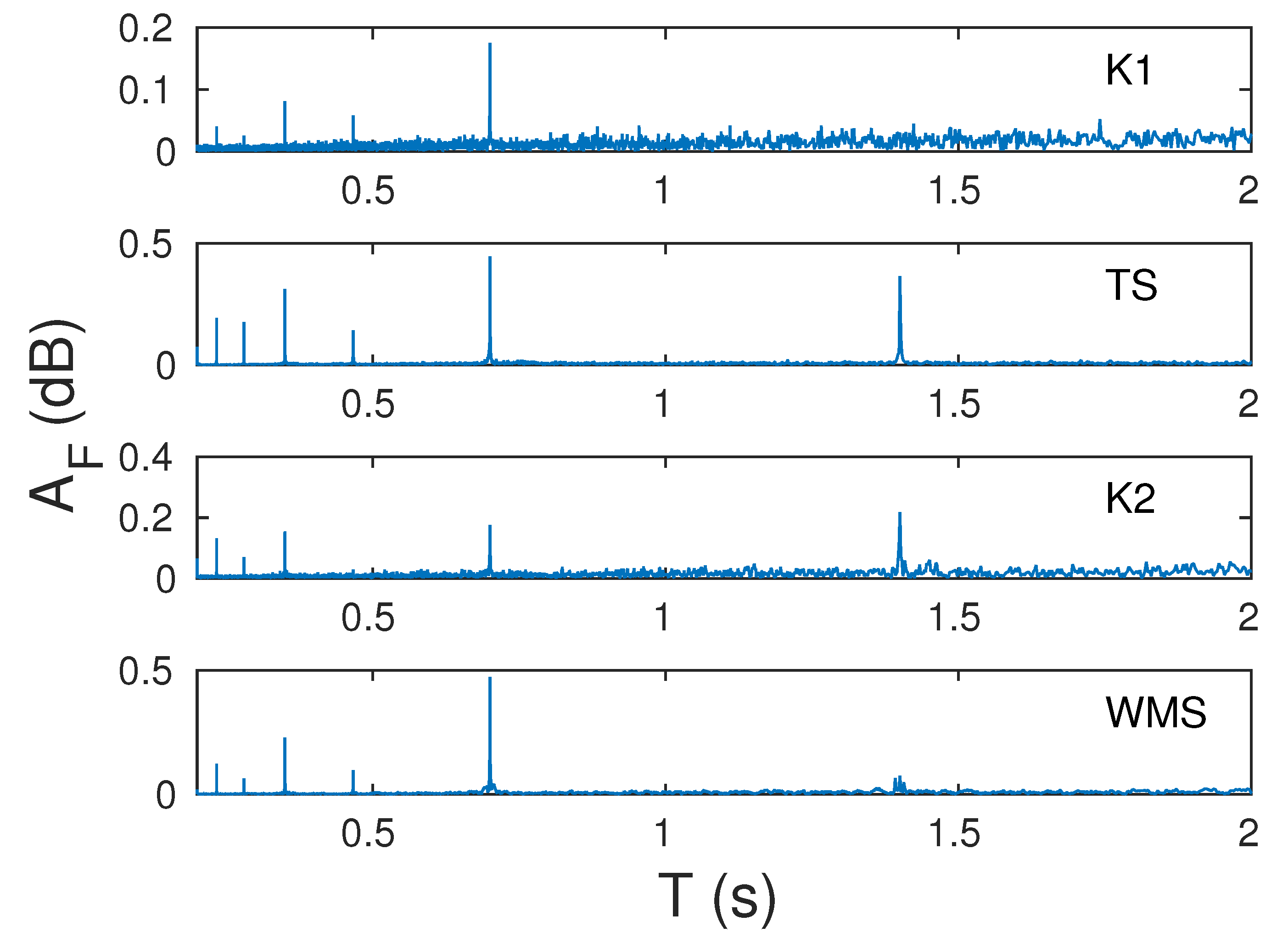
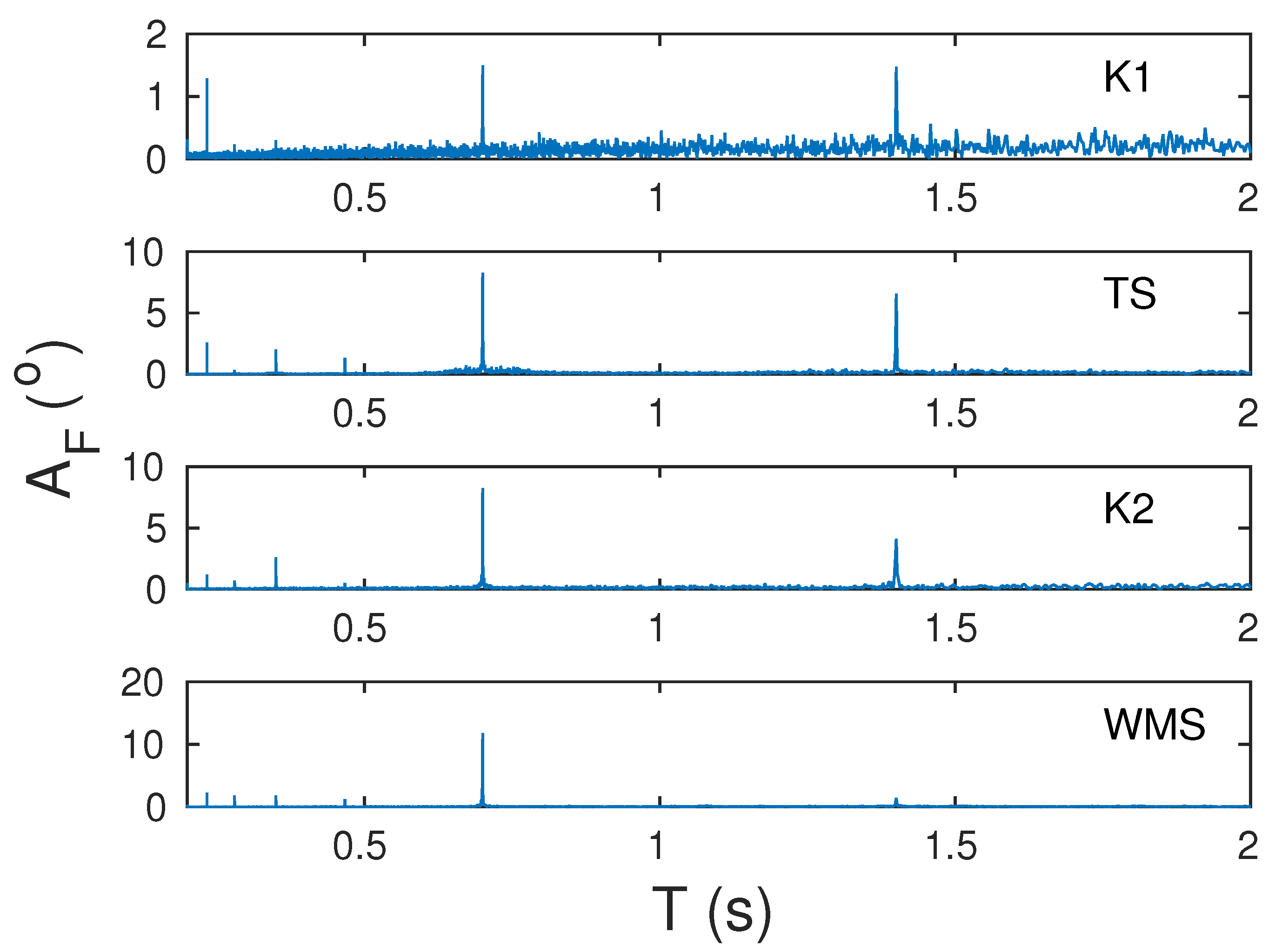
| Earthquake | Time Domain | Frequency Domain |
|---|---|---|
| Amplitude | ||
| K1 | [11] | [11] |
| TS | [11] | this study |
| K2 | [11] | this study |
| WMS | [11] | this study |
| Phase | ||
| K1 | [22] | [22] |
| TS | [22] | [22] |
| K2 | [22] | [22] |
| WMS | [22] | [22] |
| t (UT) | Position (LAT/LON) | Magnitude | Location |
|---|---|---|---|
| 17:12:30 | (42.4°N, 13.35°E) | ML 2 | Central Italy |
| 17:48:04 | (43.75°N, 20.7°E) | ML 2.5 | near Kraljevo |
| 18:13:10 | (40.03°N, 13.2°E) | mb 5.1 | TS |
| 18:47:23 | (43.73°N, 20.67°E) | ML 2.1 | near Kraljevo |
| t (UT) | Position (LAT/LON) | Magnitude | Location |
|---|---|---|---|
| 20:33:01 | (43.75°N, 20.7°E) | ML 1.9 | near Kraljevo |
| 21:09:05 | (43.78°N, 20.62°E) | ML 4.4 | near Kraljevo |
| 21:55:40 | (45.81°N, 7.55°E) | ML 1.2 | Northern Italy |
| 23:43:05 | (43.78°N, 20.62°E) | ML 3.3 | near Kraljevo |
| 00:16:14 | (43.74°N, 20.64°E) | ML 2.8 | near Kraljevo |
| 01:38:48 | (43.76°N, 20.69°E) | ML 2.5 | near Kraljevo |
| t (UT) | Position (LAT/LON) | Magnitude | Location |
|---|---|---|---|
| 16:45:13 | (43.59°N, 12.36°E) | ML 2.3 | Central Italy |
| 18:23:36 | (42.25°N, 6.77°E) | ML 4.3 | WMS |
| Earthquake | Domain | Parameter | Start | End | ||
|---|---|---|---|---|---|---|
| K1 | t | −45 min | −45 min | 5 h 50 min | 5 h 50 min | |
| f | −50 min | −50 min | 5 h 50 min | 5 h 50 min | ||
| TS | t | −25 min | −25 min | 2 h 23 min | 2 h 23 min | |
| f | −40 min | −40 min | 2 h 10 min | 2 h 10 min | ||
| K2 | t | −6 min 30 s | −6 min 30 s | 13 min 30 s | 13 min 30 s | |
| f | −20 min | −20 min | 10 min | 10 min | ||
| WMS | t | −1 h 35 min | −1 h 15 min | 35 min | 33 min | |
| f | −1 h 40 min | −1 h 40 min | 30 min | 30 min | ||
| Earthquake | A/P | (s) | ||||||
|---|---|---|---|---|---|---|---|---|
| 0.2000 ± 0.0001 | 0.2333 ± 0.0001 | 0.2800 ± 0.0001 | 0.3500 ± 0.0002 | 0.4667 ± 0.0002 | 0.7001 ± 0.0005 | 1.400 ± 0.002 | ||
| K1 | A | + | + | + | + | + | ||
| P | + | + | + | + | + | + | + | |
| TS | A | + | + | + | + | + | + | |
| P | + | + | + | + | + | + | ||
| K2 | A | + | + | + | + | + | + | + |
| P | + | + | + | + | + | + | ||
| WMS | A | + | + | + | + | + | + | |
| P | + | + | + | + | + | + | ||
| Earthquake | (min) | (min) |
|---|---|---|
| K1 | ≈6.67 | at least 90 |
| TS | ≈15 | at least 90 |
| K2 | ≈6.667 | 60–90 |
| WMS | ≈5.455 | at least 90 |
Disclaimer/Publisher’s Note: The statements, opinions and data contained in all publications are solely those of the individual author(s) and contributor(s) and not of MDPI and/or the editor(s). MDPI and/or the editor(s) disclaim responsibility for any injury to people or property resulting from any ideas, methods, instructions or products referred to in the content. |
© 2024 by the author. Licensee MDPI, Basel, Switzerland. This article is an open access article distributed under the terms and conditions of the Creative Commons Attribution (CC BY) license (https://creativecommons.org/licenses/by/4.0/).
Share and Cite
Nina, A. Analysis of VLF Signal Noise Changes in the Time Domain and Excitations/Attenuations of Short-Period Waves in the Frequency Domain as Potential Earthquake Precursors. Remote Sens. 2024, 16, 397. https://doi.org/10.3390/rs16020397
Nina A. Analysis of VLF Signal Noise Changes in the Time Domain and Excitations/Attenuations of Short-Period Waves in the Frequency Domain as Potential Earthquake Precursors. Remote Sensing. 2024; 16(2):397. https://doi.org/10.3390/rs16020397
Chicago/Turabian StyleNina, Aleksandra. 2024. "Analysis of VLF Signal Noise Changes in the Time Domain and Excitations/Attenuations of Short-Period Waves in the Frequency Domain as Potential Earthquake Precursors" Remote Sensing 16, no. 2: 397. https://doi.org/10.3390/rs16020397
APA StyleNina, A. (2024). Analysis of VLF Signal Noise Changes in the Time Domain and Excitations/Attenuations of Short-Period Waves in the Frequency Domain as Potential Earthquake Precursors. Remote Sensing, 16(2), 397. https://doi.org/10.3390/rs16020397





